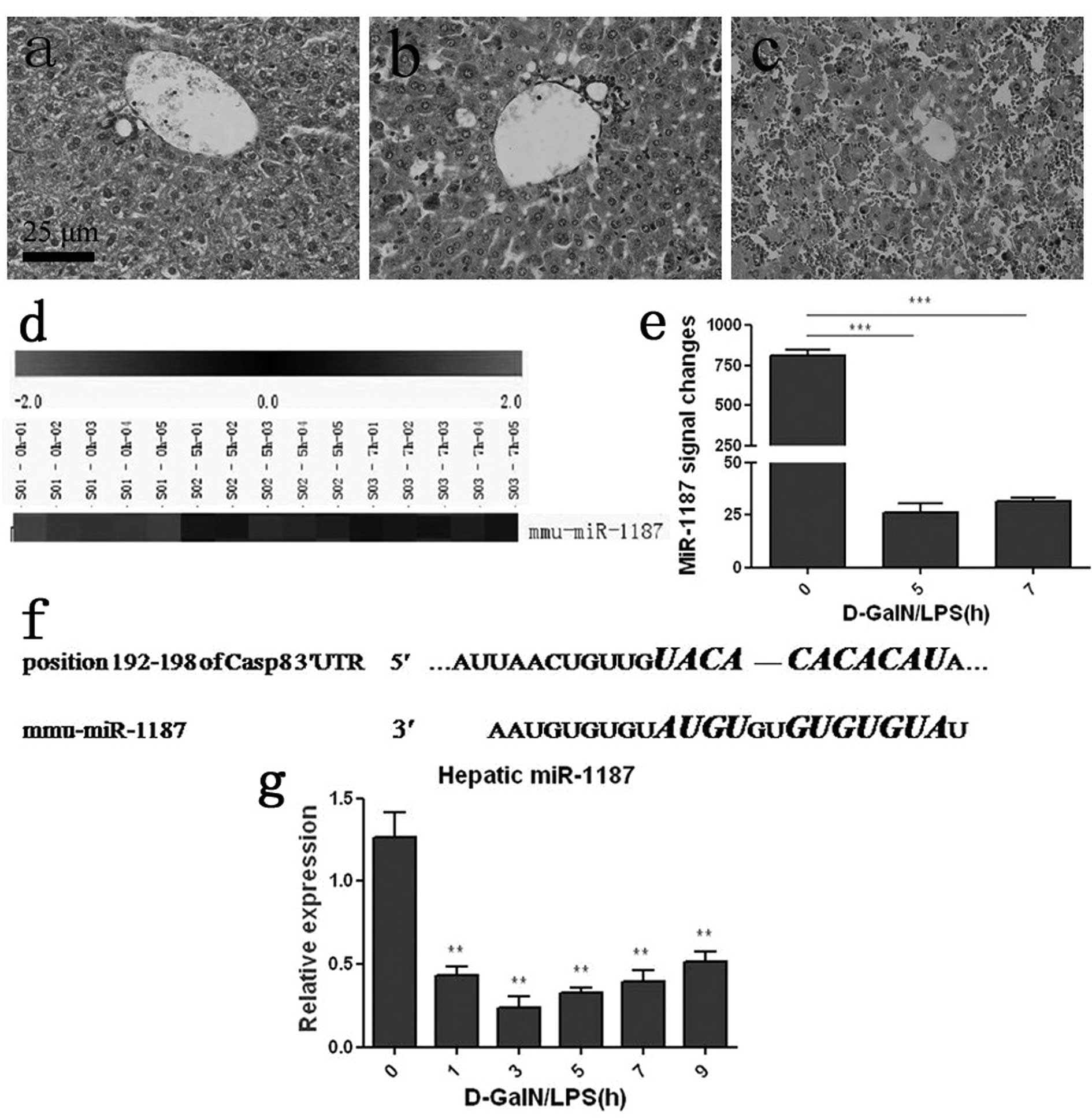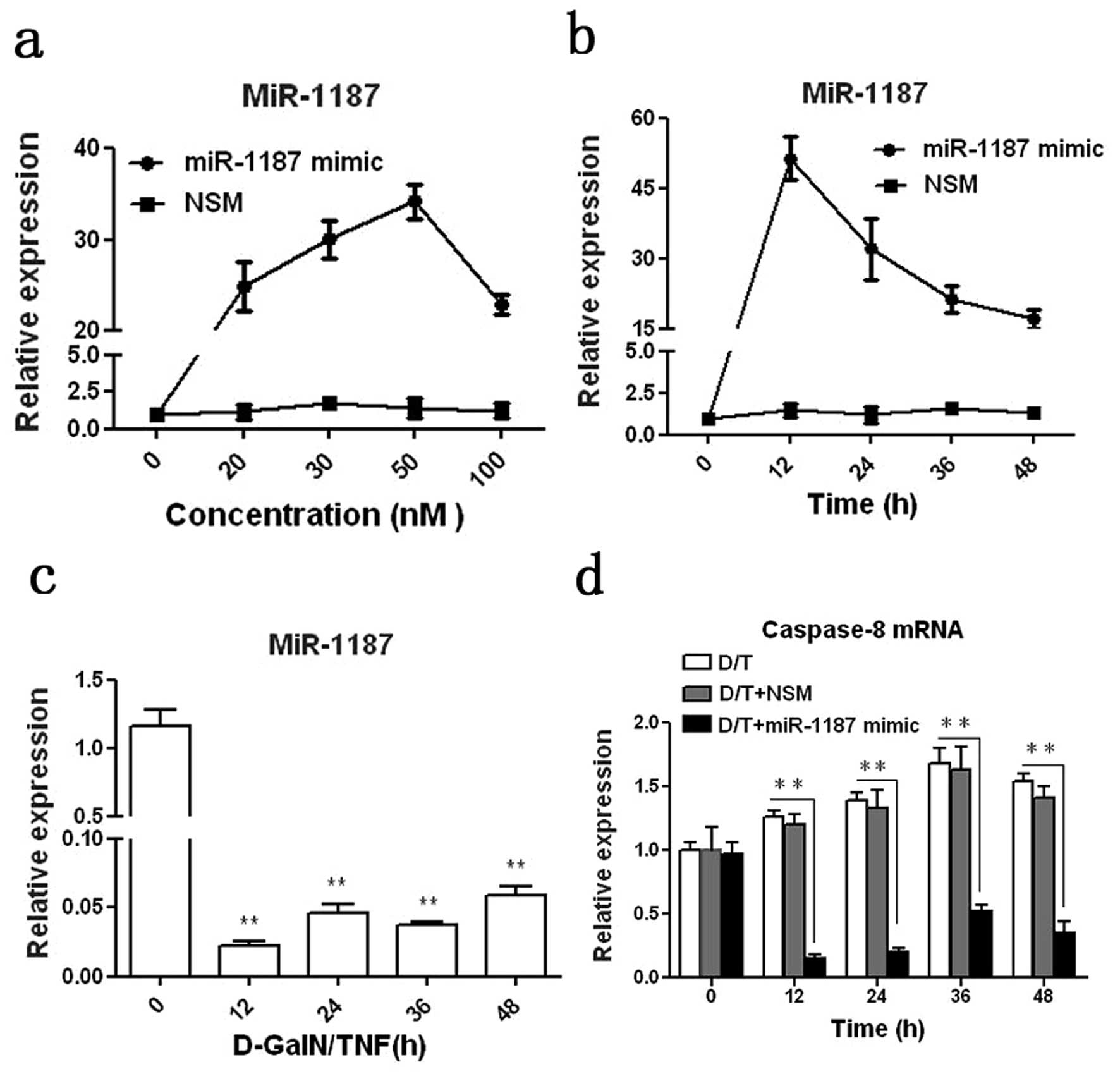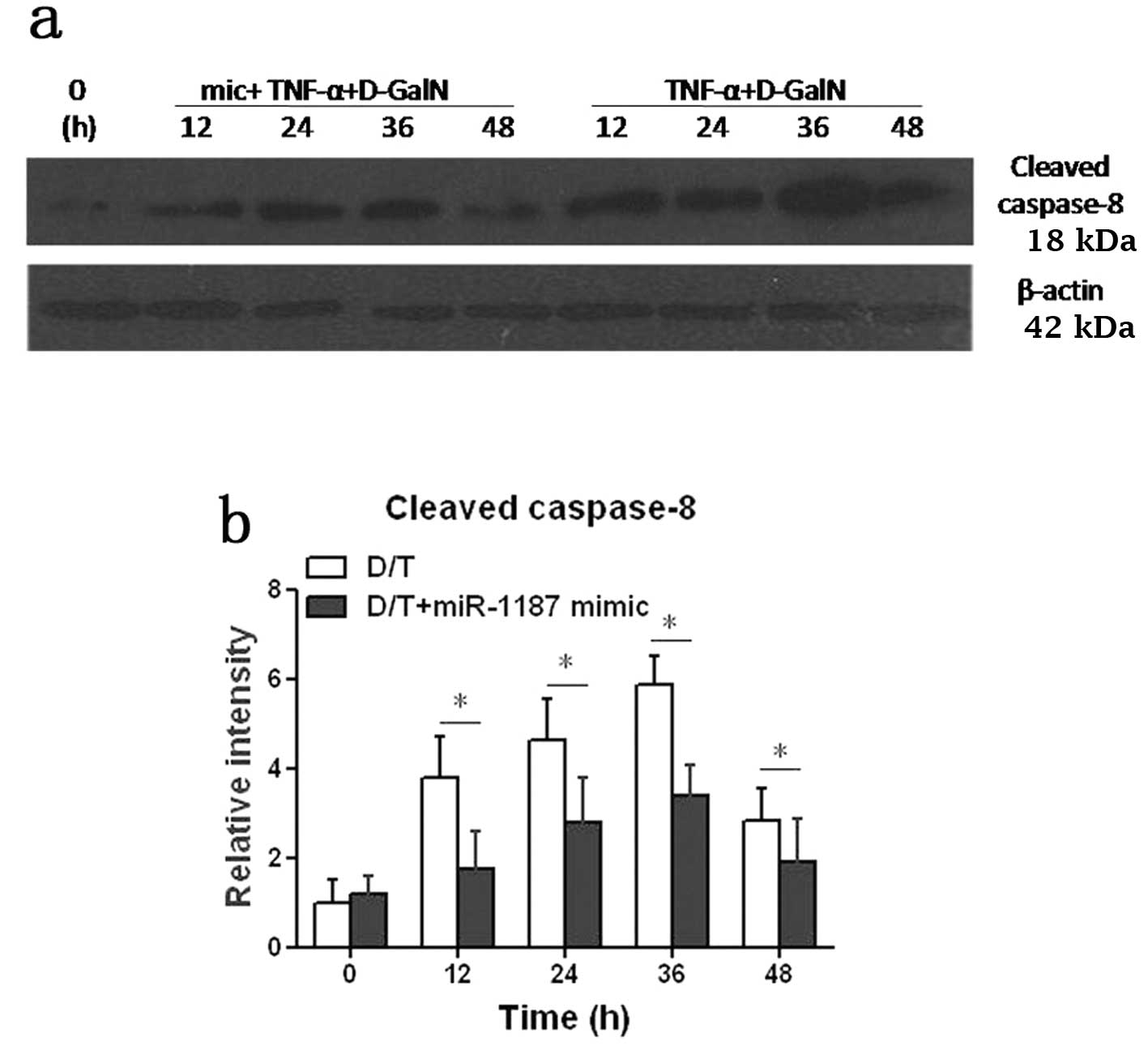The regulatory role of microRNA-1187 in TNF-α-mediated hepatocyte apoptosis in acute liver failure
- Authors:
- Published online on: January 17, 2012 https://doi.org/10.3892/ijmm.2012.888
- Pages: 663-668
Abstract
Introduction
Acute liver failure (ALF) is a complex multisystemic disease with degeneration and necrosis of the liver which induces serious hepatosis, disturbances of blood coagulation, jaundice, hepatic encephalopathy and high mortality rates (1). Worldwide, the most frequent cause of ALF is viral hepatitis, such as hepatitis B and hepatitis C (2). Recent research suggests that apoptosis, infiltration of inflammatory cells and microcirculatory disturbance play important roles in the process of ALF (3,4). Apoptosis of hepatocytes was mediated by death receptors such as Fas, tumor necrosis factor (TNF)-α, and TNF related apoptosis-inducing ligand (TRAIL) (5,6), which have been implicated in hepatitis including hepatitis B virus (HBV) and hepatitis C virus (HCV) infection (7,8).
Caspase-8, a key protease in the death receptor signaling pathways, is activated when receiving apoplectic signals and is turned into cleaved caspase-8. Cleaved caspase-8 may activate caspase-3, caspase-9, eliminate Bcl-2 and may initiate apoptosis (9). Thus, caspase-8 is an ideal target factor for inhibiting apoptosis. The discovery of small non-coding RNA called microRNA (miRNA) has greatly expanded our understanding of the cellular mechanisms that regulate gene expression and immunology (10,11). Many studies have found that the miRNA expression profile is altered in liver diseases (12,13). Lanford et al reported that SPC3649 blocked miR-122 and effectively inhibited HCV replication and improved the pathological state of the liver in HCV model animals (14). Yoo et al unraveled a novel mechanism by which increased RNA-induced silencing complex (RISC) activity might contribute to hepatocarcinogenesis (15).
Our previous studies found that the expression profile of hepatic miRNAs in ALF mice is significantly altered. We found that hepatic miR-122, a liver specific miRNA, was decreased and correlated reversely with hepatic damage (16). We also found miRNAs including miR-155, miR-146a, miR-125a, miR-15b and miR-16 were up-regulated and miR-1187 was down-regulated significantly during ALF in mice (17). These studies suggest that miRNAs play regulatory roles in ALF. However, it is still unclear whether down-regulation of miR-1187 plays a role in hepatocyte apoptosis. In the current study, we report a possible role of miR-1187 in hepatocyte apoptosis in ALF mice.
Materials and methods
Animal model of ALF
Male BALB/c mice (10-weeks-old) weighing 20–22 g, obtained from Shanghai SLAC Laboratory Animal Co., Ltd., (Shanghai, China), were housed under conventional laboratory conditions with food and water ad libitum. Experiments adhered to the guidelines of the Shanghai Jiaotong University Animal Ethics Committee.
A murine ALF model was induced by intraperitoneal injection of D-GalN (Sigma-Aldrich, St. Louis, MO, USA) (900 μg/kg of body weight) and LPS (Sigma-Aldrich) (10 μg/kg body weight) as described (18), whereas the control group was given saline only. The challenged mice were sacrificed at different time points (n=8 per group). Part of the liver was stored in liquid nitrogen for qRT-PCR and Western blotting, whereas another part was fixed in 10% formalin for histopathology.
Histopathology
Formalin fixed livers were embedded in paraffin, for routine histological analysis, 5 μm sections were cut and stained with hematoxylin and eosin (H&E).
RNA extraction and quantitative real-time reverse transcription polymerase chain reaction (qRT-PCR)
Total RNA was extracted from liver tissue or cells, using Trizol (Invitrogen, Paisley, UK) according to the manufacturer’s instructions. qPCR was used to confirm the expression of miR-1187 and caspase-8 mRNA. cDNA was synthesized using reverse transcriptase (37°C for 30 min, 85°C for 5 min; Takara Bio, Inc., Ohtsu, Shiga, Japan). qRT-PCR was performed with the SYBR-Premix Ex TaqII (Takara Bio, Inc.) with the ABI 7500 qPCR system (95°C for 30 sec, 95°C for 5 sec, and 60°C for 34 sec) (Applied Biosystems, Foster City, CA, USA) (19). qPCR was performed, using primers described in Table I to detect mouse miR-1187 with U6 as an internal control, while for caspase-8 β-actin was used as internal control. The quantity of miRNA was calculated with the formula 2−ΔΔCT (the CT value represents fluorescence reached the threshold number of cycles required for PCR) (20).
Cell culture and apoptosis induction
The normal mouse embryonic liver cell line (BNLCL2) (21) obtained from the Cell Bank, Chinese Academy of Science, was maintained in Dulbecco’s modified Eagle’s medium (DMEM; Invitrogen, Carlsbad, CA, USA) supplemented with 10% FBS (Gibco-Invitrogen, Carlsbad, CA, USA) and 1% streptomycin (Gibco-Invitrogen) at 37°C with 5% CO2. TNF-α (10 μg/ml; Sigma-Aldrich) and D-GalN (1.0 mg/ml; Sigma-Aldrich) were added into cell culture medium for induction of apoptosis (22), whereas the mock-treated cells were given culture medium only. Part of the cells was collected for total RNA extraction, while the other was collected for Annexin-V-FITC/PI-labeled (Mai Bio, Shanghai, China) flow cytometric analysis. FITC-positive and PI-negative cells were considered as apoptotic cells and PI-positive cells were considered as necrotic, while unstained cells were normal viable cells. FCSExpressV3Full software (De Novo Software, Thornhill, Canada) was requested for apoptotic profiles analysis.
Transfection of the miR-1187 mimic and non-specific mimic
miRNA mimics are small double-stranded RNA oligonucleotides designed to mimic (overexpression) endogenous mature miRNA molecules when transfected into cells. The synthesized miR-1187 mimic and non-specific mimic (NSM) were purchased from RiboBio (Guangzhou, China). BNLCL2 cells (50–70% confluent) were transiently transfected with miR-1187 mimic (50 nM) using Lipofectamine 2000 (Invitrogen, Carlsbad, CA, USA) following the manufacturer’s instruction; NSM (50 nM) was transfected as a negative control. The efficiency of transfection was analysed using qRT-PCR.
Western blot analysis
Total protein from BNLCL2 cells was extracted with extraction buffer RIPA plus the protease inhibitor PMSF (Bocai Bio Co., Shanghai, China) and quantified by the bicinchoninic acid (BCA) method (Pierce, Rockford, IL, USA). Protein samples were size-fractionated on 8% SDS-polyacrylamide gels and transferred to PVDF membranes (Amersham, Buckinghamshire, UK). The membranes were blocked with 5% dry milk for 1 h in Tris-saline buffer and 0.1% Tween-20 (TBS/Tween-20) (Dako, Carpinteria, CA, USA). After washing in TBS/Tween-20, the membranes were incubated with rabbit anti-mouse caspase-8 polyclonal antibody or rabbit anti-mouse β-actin polyclonal antibody (1:2,000, Abcam, Cambridge, UK) overnight at 4°C. After washing with TBS/Tween-20, the membranes were incubated for 1 h at room temperature with HRP-conjugated goat anti-rabbit IgG (1:2,000, Abcam, Cambridge, UK), washed with TBS/Tween-20 and the proteins of interest on the membrane were detected with ECL Plus™ Western blotting detection reagents (Amersham).
Statistical analysis
All data are presented as means ± SD (standard deviation). Two-way ANOVA or Student’s t-test was performed for statistical analysis, using Graphpad Prism 5 (GraphPad Software, Inc.; La Jolla, CA, USA). Differences between group means with P<0.05 were regarded as being statistically significant.
Results
miR-1187 was significantly decreased during ALF and was predicted to target the caspase-8 mRNA 3′-untranslated region (3′UTR)
After D-GalN/LPS induction, the mice mortality rate was 50% at 7 h and over 80% at 24 h (data was shown). A histopathology study detected obvious damage in the liver 5 h post-challenge, which showed a large quantity of inflammatory cells and disordered hepatic lobules (Fig. 1b). At 7 h, histopathological change was pronounced and severe congestion and destructed hepatic lobules were detected (Fig. 1c). LNA-based microarray analysis showed that hepatic miR-1187 was dramatically decreased with ongoing ALF (Fig. 1d). The miR-1187 expression signal was quantified and about a 97 or 96% decrease at 5 or 7 h post challenge respectively was noted compared with 0 h (saline control) (P<0.001, Fig. 1e). qRT-PCR was applied to verify the expression of miR-1187, and the result was consistent with the microarray data (P<0.01, Fig. 1g). TargetScan (http://www.targetscan.org/) revealed that 7 nucleotides in the seed region of miR-1187 were complementary to the position 192–198 of caspase-8 mRNA 3′UTR in mice (Fig. 1f).
Overexpression of miR-1187 suppressed the level of caspase-8 mRNA as well as protein in BNLCL2 cells induced by D-GalN/TNF
In order to study the regulatory role of miR-1187 in caspase-8, we applied a miR-1187 mimic for study. It was shown that miR-1187 was overexpressed in BNLCL2 cells transfected with miR-1187 mimic compared with the cells transfected with NSM. At 50 nM the miRA-1187 mimic with 12 h transfection resulted in the highest expression of miR-1187 in BNLCL2 cells (P<0.001, Fig. 2a and b). Thus we used this condition for the whole experiment. miR-1187 was dramatically decreased in the cells induced with D-GalN/TNF (P<0.01, Fig. 2c), correlating with our in vivo data above (Fig 1d, e and g). Inversely, caspase-8 mRNA was up-regulated in BNLCL2 cells induced with D-GalN/TNF (P<0.05), but overexpression of miR-1187 reduced caspase-8 mRNA significantly (P<0.01, Fig. 2d).
Cleaved caspase-8 protein was increased in BNLCL2 cells induced by D-GalN/TNF, but it was significantly suppressed (P<0.05) when the cells were transfected with the miR-1187 mimic (D/T+1187 mimic) (Fig. 3). Taken together, it was presumed that miR-1187 regulated caspase-8 by mRNA degradation and the level of protein was suppressed accordingly.
Up-regulated miR-1187 attenuated apoptosis of BNLCL2 cells
Following the data above, it is of interest to investigate if miR-1187 regulates BNLCL2 cells apoptosis. The flow cytometry data showed that the apoptotic rate of BNLCL2 cells was increased in a time-dependent manner; it was 26, 32, 37 or 42% following the D-GalN/TNF treatment for 12, 24, 36 or 48 h respectively. However, overexpression of miR-1187 attenuated the apoptotic rate significantly, i.e. by about 21, 24, 29 and 36%, respectively (P<0.05, Fig. 4).
Discussion
Death receptor-mediated apoptosis of hepatocytes contributes to ALF (23). Recent studies found miRNAs are responsible for a number of liver diseases (24). Increasing evidence demonstrates that miRNAs regulate death receptor-mediated hepatocytes apoptosis in ALF (25,26). However, the regulatory role of miRNAs in TNF-α-dependent hepatocytes apoptosis in ALF remains unclear.
In the current study, the D-GalN/LPS induced ALF mice model was used for investigation. It was detected that miR-1187 was reduced in the liver of ALF mice by qRT-PCR. This data was consistent with our microarray data. Furthermore, using the TargetScan database, it was found that caspase-8 was a putative target of miR-1187. Fas, TNF-α and TRAIL are important genes in the death receptor-mediated apoptosis signaling pathway in human acute viral hepatitis (27,28), and caspase-8 is a key gene involved in this pathway. Caspase-8 has been implicated in hepatocyte apoptosis in liver injury (29), anti-caspase-8 could effectively inhibit apoptosis of Hepa 1-6 cells induced by TNF-α (30) and caspase-8 small interfering RNA prevents mice from acute liver failure (31). Thus, it is reasonable to conclude that miR-1187 contributes to hepatocyte apoptosis via targeting caspase-8 during ALF.
In order to study the role of miR-1187 in hepatocytes apoptosis, D-GalN/TNF was applied to induce BNLCL2 to apoptosis. After induction, a down-regulation of miR-1187 but an up-regulation of caspase-8 (both mRNA and protein level) was detected. Moreover, overexpression of miR-1187 reduced the levels of caspase-8 mRNA and protein and attenuated the apoptotic rate as well. Taken together, we speculate that overexpression of miR-1187 suppresses caspase-8, then down-regulates downstream genes including caspase-3, caspase-7 and caspase-9, consequently attenuating the apoptosis of hepatocytes. However, the relationship between miR-1187 and other factors related with immunization and apoptosis and how miR-1187 plays a role in an in vivo environment, remain to be further investigated.
In summary, our study demonstrated that miR-1187 regulated hepatocytes apoptosis via targeting caspase-8. miR-1187 acted as an inhibitor of hepatocyte apoptosis which shed light on the treatment of ALF.
Acknowledgements
This study was supported by the National Natural Science Foundation of China (NSFC81071358), the National Science and Technology Major Project grants (2008ZX10002-005 and 2008ZX10002-007) and a Shanghai Science and Technology Committee grant (10411966800).













